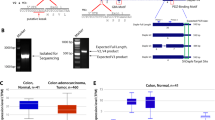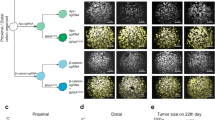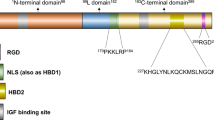Abstract
CDX2 is a Drosophila caudal-related homeobox transcription factor that is important for the establishment and maintenance of intestinal epithelial cells. We have reported that CDX2 promotes tumorigenicity in a subset of human colorectal cancer cell lines. Here, we present evidence that CDX2 negatively regulates the well-documented growth inhibitor insulin-like growth factor binding protein-3 (IGFBP-3). Specifically, CDX2 binds to the IGFBP-3 gene promoter and can repress IGFBP-3 transcription, protein expression and secretion. Furthermore, inhibition of IGFBP-3 partially rescues the decreased anchorage-independent growth phenotype observed in CDX2 knockout cells. These data demonstrate for the first time that (1) CDX2 can function as a transcriptional repressor, and (2) one mechanism by which CDX2 promotes anchorage-independent growth is by transcriptional repression of IGFBP-3.
This is a preview of subscription content, access via your institution
Access options
Subscribe to this journal
Receive 50 print issues and online access
$259.00 per year
only $5.18 per issue
Buy this article
- Purchase on Springer Link
- Instant access to full article PDF
Prices may be subject to local taxes which are calculated during checkout




Similar content being viewed by others
References
Aoki K, Tamai Y, Horiike S, Oshima M, Taketo MM . (2003). Colonic polyposis caused by mTOR-mediated chromosomal instability in Apc+/Delta716 Cdx2+/− compound mutant mice. Nat Genet 35: 323–330.
Baxter RC . (2001). Signalling pathways involved in antiproliferative effects of IGFBP-3: a review. Mol Pathol 54: 145–148.
Chawengsaksophak K, James R, Hammond VE, Kontgen F, Beck F . (1997). Homeosis and intestinal tumours in Cdx2 mutant mice. Nature 386: 84–87.
Cubbage ML, Suwanichkul A, Powell DR . (1990). Insulin-like growth factor binding protein-3. Organization of the human chromosomal gene and demonstration of promoter activity. J Biol Chem 265: 12642–12649.
Dang LH, Chen F, Ying C, Chun SY, Knock SA, Appelman HD et al. (2006). CDX2 has tumorigenic potential in the human colon cancer cell lines LOVO and SW48. Oncogene 25: 2264–2272.
Escaffit F, Pare F, Gauthier R, Rivard N, Boudreau F, Beaulieu JF . (2006). Cdx2 modulates proliferation in normal human intestinal epithelial crypt cells. Biochem Biophys Res Commun 342: 66–72.
Francis GL, Ross M, Ballard FJ, Milner SJ, Senn C, McNeil KA et al. (1992). Novel recombinant fusion protein analogues of insulin-like growth factor (IGF)-I indicate the relative importance of IGF-binding protein and receptor binding for enhanced biological potency. J Mol Endocrinol 8: 213–223.
German MS, Wang J, Fernald AA, Espinosa III R, Le Beau MM, Bell GI . (1994). Localization of the genes encoding two transcription factors, LMX1 and CDX3, regulating insulin gene expression to human chromosomes 1 and 13. Genomics 24: 403–404.
Guo RJ, Suh ER, Lynch JP . (2004). The Role of Cdx Proteins in intestinal development and cancer. Cancer Biol Ther 3: 593–601.
Heckman CA, Mehew JW, Ying GG, Introna M, Golay J, Boxer LM . (2000). A-Myb up-regulates Bcl-2 through a Cdx binding site in t(14;18) lymphoma cells. J Biol Chem 275: 6499–6508.
Heinemeyer T, Wingender E, Reuter I, Hermjakob H, Kel AE, Kel OV et al. (1998). Databases on transcriptional regulation: TRANSFAC, TRRD and COMPEL. Nucleic Acids Res 26: 362–367.
James R, Erler T, Kazenwadel J . (1994). Structure of the murine homeobox gene cdx-2. Expression in embryonic and adult intestinal epithelium. J Biol Chem 269: 15229–15237.
Krasinski SD, Van Wering HM, Tannemaat MR, Grand RJ . (2001). Differential activation of intestinal gene promoters: functional interactions between GATA-5 and HNF-1 alpha. Am J Physiol Gastrointest Liver Physiol 281: G69–G84.
Lee HY, Chun KH, Liu B, Wiehle SA, Cristiano RJ, Hong WK et al. (2002). Insulin-like growth factor binding protein-3 inhibits the growth of non-small cell lung cancer. Cancer Res 62: 3530–3537.
Pollak MN, Schernhammer ES, Hankinson SE . (2004). Insulin-like growth factors and neoplasia. Nat Rev Cancer 4: 505–518.
Rawat VP, Cusan M, Deshpande A, Hiddemann W, Quintanilla-Martinez L, Humphries RK et al. (2004). Ectopic expression of the homeobox gene Cdx2 is the transforming event in a mouse model of t(12;13)(p13;q12) acute myeloid leukemia. Proc Natl Acad Sci USA 101: 817–822.
Renehan AG, Zwahlen M, Minder C, O'Dwyer ST, Shalet SM, Egger M . (2004). Insulin-like growth factor (IGF)-I, IGF binding protein-3, and cancer risk: systematic review and meta-regression analysis. Lancet 363: 1346–1353.
Sims III RJ, Mandal SS, Reinberg D . (2004). Recent highlights of RNA-polymerase-II-mediated transcription. Curr Opin Cell Biol 16: 263–271.
Yamamoto H, Bai YQ, Yuasa Y . (2003). Homeodomain protein CDX2 regulates goblet-specific MUC2 gene expression. Biochem Biophys Res Commun 300: 813–818.
Acknowledgements
DTD was supported by NIH Grant K08DK59970, AGA Research Scholar Award, and GIDH Basic Research Award; LHD by NIH Grant K22CA111897; JWM, JGW, and KLI by NIH University of Michigan Cancer Center Support Grant 5 P30 CA46592
Author information
Authors and Affiliations
Corresponding author
Additional information
Supplementary Information accompanies the paper on the Oncogene website (http://www.nature.com/onc).
Supplementary information
Rights and permissions
About this article
Cite this article
Chun, S., Chen, F., Washburn, J. et al. CDX2 promotes anchorage-independent growth by transcriptional repression of IGFBP-3. Oncogene 26, 4725–4729 (2007). https://doi.org/10.1038/sj.onc.1210258
Received:
Revised:
Accepted:
Published:
Issue Date:
DOI: https://doi.org/10.1038/sj.onc.1210258
Keywords
This article is cited by
-
Intestinal regulation of suppression of tumorigenicity 14 (ST14) and serine peptidase inhibitor, Kunitz type -1 (SPINT1) by transcription factor CDX2
Scientific Reports (2018)
-
Germ line knockout of IGFBP-3 reveals influences of the gene on mammary gland neoplasia
Breast Cancer Research and Treatment (2015)
-
Oncogenic KRAS modulates mitochondrial metabolism in human colon cancer cells by inducing HIF-1α and HIF-2α target genes
Molecular Cancer (2010)
-
Local IGFBP-3 mRNA expression, apoptosis and risk of colorectal adenomas
BMC Cancer (2008)



